EPS Products Reference Guide »
Box and Whisker EPSgrams
Description
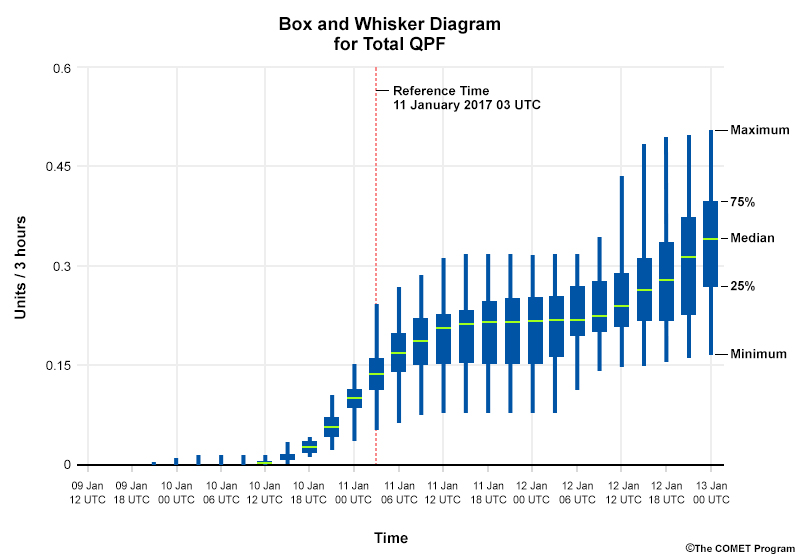
Box and whisker EPS meteograms, or EPSgrams, display probabilistic information at specific locations over time. Each time step has one rectangle (“box”) with single lines (“whiskers”) extending out from both ends. Each time step’s box and whiskers represents the full range of the ensemble solution distribution, and indicates important probabilistic quantities, including nth percentile levels and the median.
Interpretation
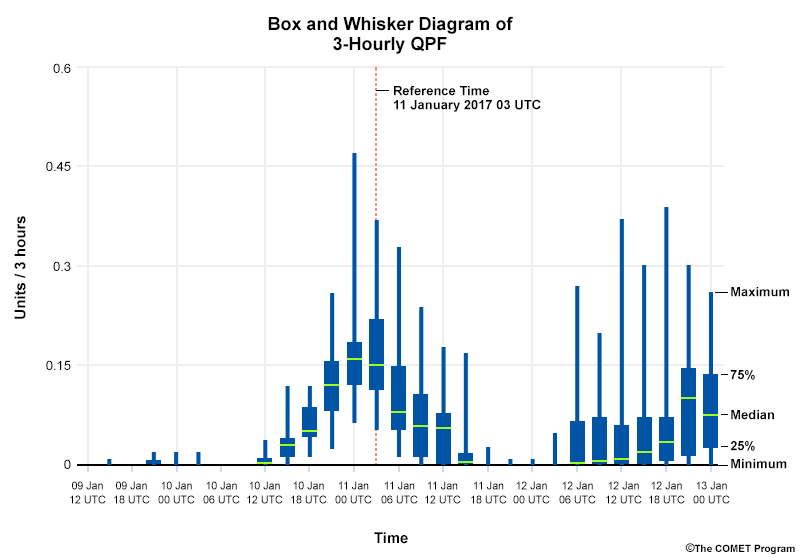
The boxes encompass common percentile ranges, such as the 25th through 75th percentiles (as seen here). Some products include a secondary, smaller set of boxes that extend from these values toward the tails of the distribution, encompassing a range such as the 75th through 90th percentiles. The median value is typically indicated by a single horizontal line through the central box.
The whiskers typically extend from the edges of the outermost box to the maximum and minimum values for the time step. In some cases, they only encompass the 10th through 90th percentiles, with the extremes indicated with symbols.
Other lines are occasionally plotted with the box and whiskers, such as model climatology and control run values (shown in the tabs below).
With Model Climatology

Box and Whiskers of maximum temperature (red) and minimum temperature (blue) along with shaded percentiles of the model climatology.
With Control Run

Box and whiskers of 12hr QPF along with the global model run (blue line), CMC control run (red line), and NCEP control run (green line).
Below is our 3-hourly QPF box and whisker diagram (inset), with the full distribution from the 14th time step shown in the foreground. The highest and lowest precipitation values predicted within the distribution are represented by the maximum and minimum whiskers respectively.
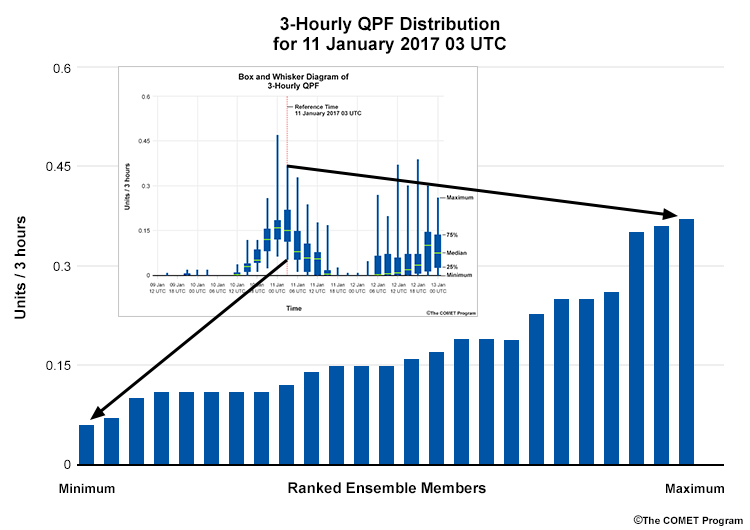
To understand the probability of a threshold being met or exceeded, use the listed percentiles. In the diagram below, there is a 75% chance of <= .22 units / 3hrs of precipitation since 75% of the ensemble members have values less than or equal to it.
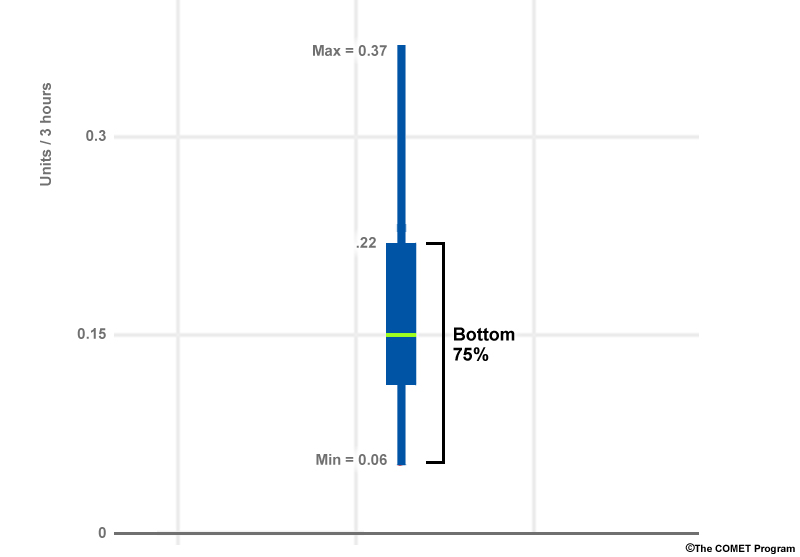
The median value often represents the most likely outcome in a normal distribution. If there is member clustering or a multimodal distribution, it is wise to consult other diagrams that display individual members, such as plume diagrams. This is discussed in more detail in a later section.
Strengths & Weaknesses
Strengths:
You can quickly and easily determine probabilities and percentiles at common intervals by inspecting the median line and the ends of the boxes and the whiskers.
General agreement between ensemble members can be estimated by the length of the boxes and whiskers: the longer they are, the greater the uncertainty in the EPS forecast. In our example, the boxes and especially the whiskers are generally longer at longer lead times, as we would expect.
Box and whisker diagrams show conditions at a specific point, which often gives a more precise value than estimating it from a point on a plan-view map.
Weaknesses
While we can easily observe the median, maximum, minimum, and common percentiles from box and whisker diagrams, we do not know the shape of the distribution. If the distribution is multimodal or clustered (as shown below in the plume diagram at 11 Jan 03 UTC), the median does not represent the most likely solution.
Study the diagram, trying to visualize the shape of the distribution for the 24 ensemble members. Then move the slider to see what the distribution actually looks like in the plume diagram.

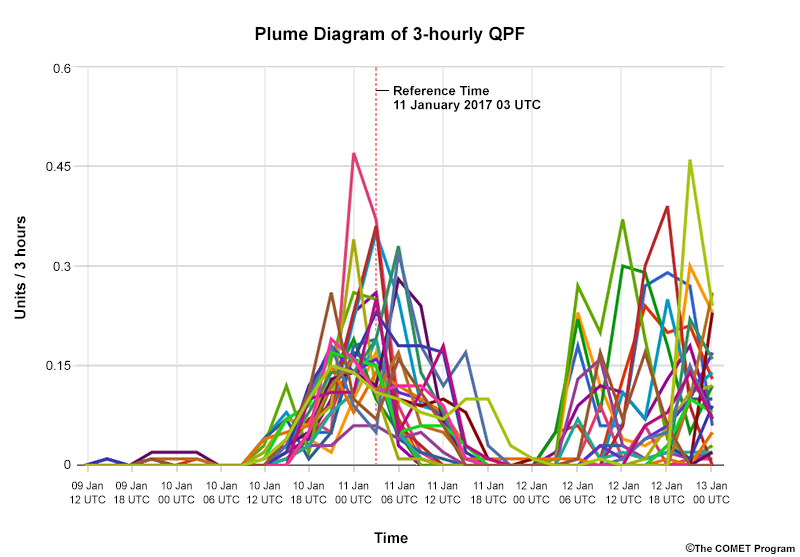
Since you cannot see the individual members spatially and temporally in box and whisker diagrams, you cannot tell if the disagreement is a result of differences in weather system timing, magnitude, or position, or combination of all three.
Furthermore, you cannot track the effects of individual members, which can be useful for determining precipitation type and other qualities. If a majority of members forecast temperatures below zero and a large number of members forecast substantial precipitation, you cannot determine the precipitation phase from a box and whisker diagram.
Tracking individual members can also be useful for determining whether members using certain model physics or parameterizations are causing clustering or outlier solutions.
An additional weakness applies to box and whisker diagrams along with point products in general. The model forecast is likely interpolated, bilinearly or using the nearest land or sea gridpoint, to the specific point location. Thus, the model is trying to represent horizontal and vertical scales that are not actually present, leading to some smoothing of forecast values.
Effective Use
Box and whisker diagrams are useful for quickly finding trends through the entire forecast period. They are best combined with other plots in the following ways.
- Use plume diagrams to view clustering and/or the multimodal shape of the distribution and determine the most likely outcome or outcomes accordingly. Plume diagrams also let you track individual members or clusters to better understand specific model impacts and assess categorical variable results. It is possible to understand timing of precipitation from box and whisker diagrams yet combined with plumes you can see which members might be faster or slower. Together you may achieve more confidence on timing at a point with these two products.
- Use plan-view maps of probability, spaghetti maps, or trajectory maps to assess member disagreement in system timing, magnitude, and/or position, and check on the potential smoothing of surrounding values for your point forecast.
Keep the following points in mind when using box and whisker diagrams.
- Examine the legend to determine which percentiles are indicated by which box and/or whisker feature.
- Examine the start and end time of each period. Also see if the data is an instantaneous value, the maximum or minimum for the period, or an accumulated value covering the beginning, middle, or end of the time step.
- If you are concerned about severe or rare events, access additional information on model or reanalysis climate or observed climatology. At long lead times, the EPS median has a tendency to gravitate asymptotically toward the model climate.
- Occasionally, a deterministic run may show values outside the range of the EPS solution set. Since deterministic runs often have smaller grid spacing than EPSs, it could indicate that small-scale features and/or topography are better resolved in the deterministic run, or that the EPS may not be adequately sampling the particular processes or regime.
- Be careful when interpreting cumulative distribution information, such as accumulated precipitation. The individual statistical quantities from smaller time steps, such as median precipitation over 6-hour periods, cannot be summed to deduce the median precipitation over 24 hours.
- Finally, for box and whiskers of wind, do not interpret the peaks of the whiskers as wind gusts. They are the maximum sustained wind produced by the ensemble.
Examples, Part 1
The following questions are based on this box and whisker diagram from Richmond, VA.

Question 1 of 2
What is the most likely amount of precipitation forecast by the ensemble between 12 UTC 2 Jan 2017 and 00 UTC 3 Jan 2017?
The correct answer is e.
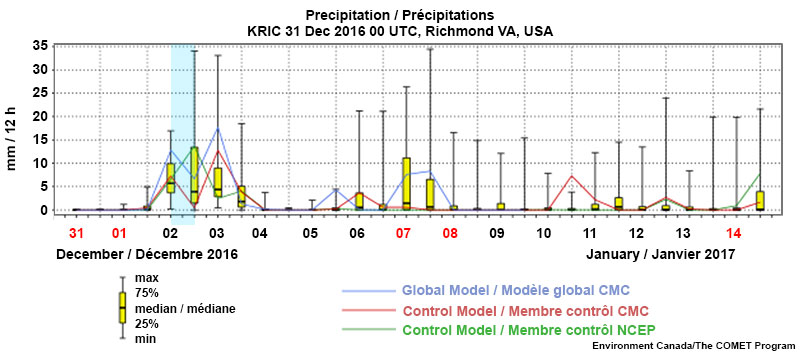
On this graphic, each vertical dotted line represents the beginning/end of a day, and each time step represents the previous 12 hours of precipitation data. You can deduce this because no precipitation box and whisker is shown at the initialization time; twelve hours must elapse for the precipitation to accumulate. So the accumulated precipitation in each time step is for the previous 12 hours. This may not be the case on all box and whiskers so make sure you know how to read your specific graphics.
With this information, we look at the 6th time step to determine the possible precipitation. The median value is approximately 4 mm. However, we should not assume that it necessarily represents the most likely amount of precipitation because we do not know if the distribution is normal within that time period. We would have to look at another diagram to see if the distribution was normal or not. Thus, the correct answer is E.
Question 2 of 2
What other product would be MOST useful in determining the most likely amount of precipitation forecast for this location during this period?
The correct answer is b.
A plume diagram for the same station would let you determine whether the members were roughly normally distributed, multimodal, or skewed. This would let you gauge whether the median was representative of a most likely solution. This makes choice B correct.
Examples, Part 2
The following questions are based on the same box and whisker diagram from Richmond, VA.

Question 1 of 2
What is the maximum amount of precipitation possible from 00 UTC through 12 UTC 2 Jan 2017?
The correct answer is b.
That period (the 5th time step) has a maximum value of approximately 17 mm.
Question 2 of 2
What is the likelihood of <= 5 mm of precipitation per 12 hours from 12 UTC 3 Jan 2017 through 00 UTC 4 Jan 2017?
The correct answer is b.
Follow the dotted line across the graph from the 5 mm / 12h value until you intersect the 8th time step. Its likelihood is 75%.
Links
- NAEFS EPSgrams: https://weather.gc.ca/ensemble/naefs/EPSgrams_e.html